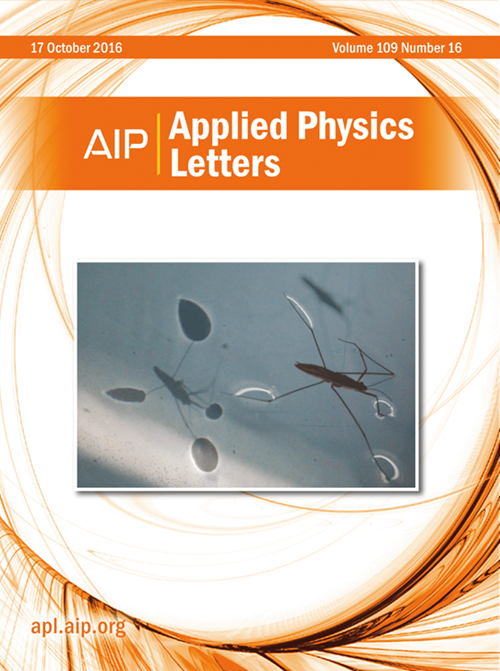杰纳斯铁谷材料 H-FeClBr 中的巨相关、多体和激子效应
IF 3.6
2区 物理与天体物理
Q2 PHYSICS, APPLIED
引用次数: 0
摘要
过渡金属二氯化物家族最近被发现是铁谷材料,表现出理想的自发谷极化,这是实际应用的关键。在这项研究中,我们通过第一原理计算,以 Janus 单层 H-FeClBr 为案例进行了研究。我们重点研究了巨相关效应、多体效应和激子效应,这些效应将从根本上调节电子、谷光和光学特性。H-FeClBr 具有很强的铁磁性和自旋轨道耦合,从而产生了很大的自发谷极化。由于铁原子局域 d 电子的巨大电子相关性,使用 Hubbard U 和混合函数 HSE06 计算出的能隙比 Perdew-Burke-Ernzerhof (PBE) 对应能隙扩大了约七倍。因此,谷带中的轨道发生了交换,谷贝里曲率的符号发生了转换,谷极化发生了逆转。GW 计算进一步将间隙显著提高到约 4 eV,接近 PBE 间隙的十倍,表明存在非常强的多体效应。通过求解 Bethe-Salpeter 方程得到的激子谱显示了巨大的电子-空穴相互作用,产生了 1.54 eV 的巨大激子结合能。与 MoS2 光谱中的 A 和 B 激子峰相对应,在具有不等间隙的两个不等价谷中存在两个分裂的激子峰,而这两个激子峰与同一谷中的光学跃迁相对应。本文章由计算机程序翻译,如有差异,请以英文原文为准。
Giant correlation, many body and exciton effects in Janus ferrovalley material H-FeClBr
The family of transition metal dichlorides are recently found to be ferrovalley materials, exhibiting desirable spontaneous valley polarization that is a key to practical applications. In this work, Janus monolayer H-FeClBr is investigated as a case study by performing first-principles calculations. We focus on the giant correlation and many-body and exciton effects that will essentially modulate the electronic, valleytronic, and optical properties. The H-FeClBr presents strong ferromagnetism and spin–orbit coupling, giving rise to large spontaneous valley polarization. Due to the enormous electron correlation of the localized d electrons of the Fe atoms, the energy gap calculated using Hubbard U and hybrid functional HSE06 is extraordinarily widened by about seven times with respect to the Perdew–Burke–Ernzerhof (PBE) counterpart. As a result, the orbitals in valley bands are exchanged, the sign of the valley Berry curvatures is switched, and the valley polarization is reversed. The GW calculations further enhance the gap significantly to about 4 eV, which is close to ten times that of the PBE gap and indicative of very strong many-body effects. The exciton spectrum obtained by solving the Bethe–Salpeter equations reveals colossal electron–hole interaction, giving rise to a giant exciton binding energies of ∼1.54 eV. Corresponding to the optical excitation in the two inequivalent valleys with unequal gaps, there are two split exciton peaks, as opposed to the A and B exciton peaks in MoS2 spectrum, which correspond to the optical transitions in the same valley.
求助全文
通过发布文献求助,成功后即可免费获取论文全文。
去求助
来源期刊

Applied Physics Letters
物理-物理:应用
CiteScore
6.40
自引率
10.00%
发文量
1821
审稿时长
1.6 months
期刊介绍:
Applied Physics Letters (APL) features concise, up-to-date reports on significant new findings in applied physics. Emphasizing rapid dissemination of key data and new physical insights, APL offers prompt publication of new experimental and theoretical papers reporting applications of physics phenomena to all branches of science, engineering, and modern technology.
In addition to regular articles, the journal also publishes invited Fast Track, Perspectives, and in-depth Editorials which report on cutting-edge areas in applied physics.
APL Perspectives are forward-looking invited letters which highlight recent developments or discoveries. Emphasis is placed on very recent developments, potentially disruptive technologies, open questions and possible solutions. They also include a mini-roadmap detailing where the community should direct efforts in order for the phenomena to be viable for application and the challenges associated with meeting that performance threshold. Perspectives are characterized by personal viewpoints and opinions of recognized experts in the field.
Fast Track articles are invited original research articles that report results that are particularly novel and important or provide a significant advancement in an emerging field. Because of the urgency and scientific importance of the work, the peer review process is accelerated. If, during the review process, it becomes apparent that the paper does not meet the Fast Track criterion, it is returned to a normal track.
 求助内容:
求助内容: 应助结果提醒方式:
应助结果提醒方式:


